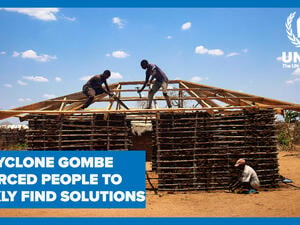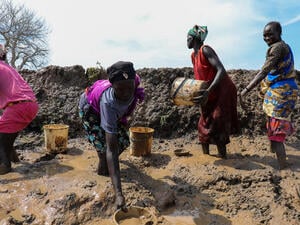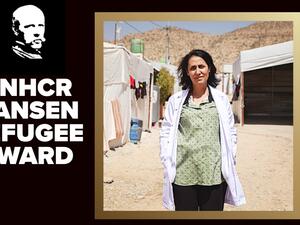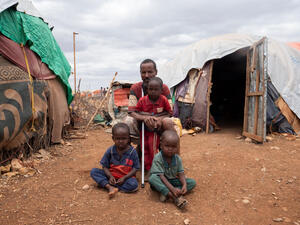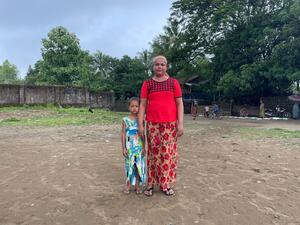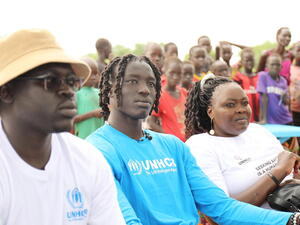Q&A: UNHCR seeks prevention, protection and solutions for Colombia's displaced
Q&A: UNHCR seeks prevention, protection and solutions for Colombia's displaced
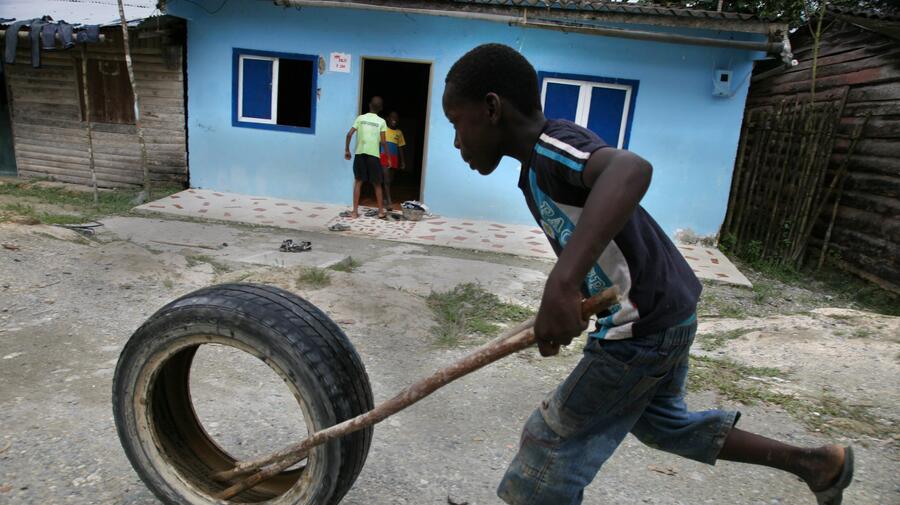
A young Afro-Colombian boy plays in a community of displaced people near the Pacific coast. The Afro-Colombians are among those of of particulalr concern to UNHCR.
BOGOTÁ, Colombia, August 25 (UNHCR) - Last month, UNHCR Web Editor Leo Dobbs travelled to South America for a first-hand look at some of the refugee agency's work in Colombia and neighbouring Ecuador. The two countries are linked by Colombia's decades-long conflict, which has forced millions of civilians to flee their homes and seek shelter in other parts of their country or in neighbouring states such as Venezuela and Ecuador. In Bogotá, Dobbs spoke with UNHCR Representative to Colombia Terry Morel, a qualified lawyer and social worker, about the work carried out by her staff and the challenges they face in the agency's largest operation in the Western Hemisphere. Excerpts from the interview:
Tell us about the main issues in Colombia
It's worth highlighting why we are here in Colombia, because it's not a typical refugee operation. It's basically about internally displaced persons, but we do have a small refugee group - 204 refugees and 149 asylum-seekers. The government takes responsibility for refugee status determination, but we are here to assist and support refugees as required and we work closely with the Catholic Church - the Pastoral Social, a key partner for UNHCR.

Terry Morel visits San Jose del Guaviare in eastern Colombia earlier this month.
In terms of internally displaced people, according to government statistics Colombia has some 3.4 million since registration began in 1997. There are a number of challenges, not least the lack of visibility and awareness of the situation in Colombia, so people overseas are unaware of the difficulties that internally displaced people are facing. Whilst it's true that the security situation has improved, this does not mean displacement has ended, rather the nature of the conflict has evolved. It has moved more to border areas and some of the central zones. We can see a spillover effect [of violence] in the border areas into Ecuador and Venezuela.
The illegal armed actors involved also appear to be changing. Before, we had the guerrillas, paramilitary groups and drug trafficking gangs. Following an agreement between paramilitary groups and the government [in 2006], the paramilitary groups and some members of the guerrilla groups began benefitting from demobilization schemes. But over the past year or two we've seen a worrying increase in what the government calls criminal armed groups . . . It's not clear if these are linked to earlier paramilitary groups. The government states that there is a clear distinction, but in some cases people say the groups are the same paramilitaries using new names. This is important for the registration of internally displaced people, because there is a tendency to reject those who are not displaced due to threats from traditional illegal armed groups.
So what is UNHCR's main focus?
Our three main priorities in the coming years are prevention, protection and solutions. Our thematic priorities are cross-cutting and include public policy, registration of displaced people, a differential approach and land, which is critical to finding a way forward for the displaced as one outcome of the conflict has been the illegal transfer of land and property. In terms of solutions, the government has a programme around return, but it doesn't necessarily meet the expectations of many IDPs [internally displaced people]. Surveys indicate that only a small number of the displaced are interested in returning. This is a concern and therefore we need to look more closely at relocation schemes and local integration options. We know that a lot of young people may not wish to go back. This is normal as time passes and their expectations change. We have to look at facilitating solutions in the urban context, which is particularly complex given the range of needs and because many IDPS are squatters. So we work closely with the local authorities and civil institutions.
What presence does UNHCR have in Colombia?
To support our strategy of prevention, we've recently increased the number of offices. We've opened a couple more in the deep field, so we now have 13 offices in the field plus Bogotá. We have about 160 staff across the country.
Having so many offices suggests the challenges are widespread
Yes, and it also reflects the geographical reality of Colombia. Violence is more intense along the borders, the Pacific coast and some of the central areas. With more than 3 million displaced and no camps, people are very dispersed and we have urban and rural IDPs populations. So it makes for a complicated operation. There are offices in large cities like Medellin and Barranquilla. In urban areas, the displaced are living on illegal land in poor neighbourhoods with the host communities. Displacement does not necessarily lead to safety and security, as there is violence in the urban areas due to the presence of illegal armed groups. In addition to persecuting some individuals, some of the illegal actors try to impose social control and threaten drug takers, sex workers, those believed to have HIV. The result is inter-urban displacement.
In Soacha [on the outskirts of Bogotá] hundreds of murders were recorded between 2000 and 2004. No UN agencies had a presence in that area and the police didn't go in. It is an interesting example of how UNHCR began working with IDPs in poor urban areas. We established a presence and worked with other institutions to open a UN house. This was followed by a House of Rights to provide people with access to the local institutions. Breaking new ground in working with IDPs in urban areas was critical because it meant people did not feel abandoned. It gives the displaced a chance to have their voices heard and to start to tend to critical needs, especially in education and health, as well as to discover their rights.
What is this strategy of prevention that you mentioned earlier?
In short, We go where other people don't go to help draw in the civilian institutions as well as accompany communities in more isolated areas. This whole notion of prevention is not particularly common in UNHCR. It's also one way of helping to keep the humanitarian space open for communities in remote areas, and this is vital. We try to encourage civilian institutions to establish greater presence in these somewhat abandoned areas. For example, to ensure documentation we've supported mobile civil registries and more than 800,000 people have been documented. This is an important protection tool, especially for the young men. Being present in remote areas also enables us to undertake a very good protection analysis of the risks communities are facing and what gaps exist in terms of prevention and protection.
As part of our focus on prevention, we work with local communities and, in discussion with them, see what their priorities are and then we support them through practical protection projects. This is a kind of fairly fast assistance to communities to help them avoid displacement, or at least avoid having to go out of their territories and losing the possibility of returning in a relatively short period of time. The further away you flee, the more likely you are to spend more time in displacement, which means more destruction of the social fabric of the community and more suffering generally.
An example might be to facilitate access by indigenous children to education and a school where they can stay overnight. Another critical area of work is the protection of land for indigenous, Afro-Colombian and other communities. We are working with the government agency, Accion Social, and donors to try and ensure that the displaced do not become more impoverished by losing their land. To date the project has protected some 3.6 million hectares. Now, we're looking at trying to support a mobile land registry system.
Tell us more about working with indigenous tribes and Afro-Colombians
The Afro-Colombians and the indigenous people have suffered particularly from the shift in the conflict to their areas [along the borders and the Pacific coast]. It doesn't just impact on them in terms of displacement, but, for the indigenous people in particular, it destroys their community structures and their social networks. And it affects how the indigenous people can practise their traditions, especially those related to their ancestors' burial sites. On top of that, Colombia has the challenge that 34 indigenous groups have been identified by the Constitutional Court as being close to extinction. We provide support to the organizations of the indigenous and Afro-Colombian groups.
How do we work with the government?
Our role here on displacement issues is to provide technical support to the government. I think it's important to stress this, because sometimes it's not clear why we don't do more operational activities directly with the population. Colombia is a country with financial resources and tremendous professional capacity in the institutions. We have a lot of respect for their ability to do things. The struggle is how to make sure that the public policies actually translate into practice and really impact people in practical terms, especially in remote areas. So while we work closely with the government, we also accompany the communities closely to improve the response by the authorities at the local level.
How important are our partners?
They are critical because we don't do a lot of direct implementation. We have close working relations with many local NGOs, the authorities at the municipal and departmental level as well as the Church, international NGOs and sister UN agencies. Accion Social is a very important partner for us.
As we're talking about people displaced within their own country, working with the government structures and state institutions is the starting point. Nonetheless, there are mixed feelings towards the displaced. I've had people say to me, "We don't want to fund a local integration solution because what happens if more IDPs come to the area as a result." That's always the big fear - the pull factor. But we know in practice that it does not become a pull factor, because people do not flee home simply because they feel like it . . . So we have to work a lot on these attitudinal issues and show that a good example of local integration is to the benefit of all.
It's very important that people in Colombia understand that nobody wants to be displaced, as IDPs here are often discriminated against and stigmatized. People want solutions. They want to be able to proudly say, "I'm a citizen of Medellin," or "I'm a citizen of Soacha" and not "I'm a displaced person."

